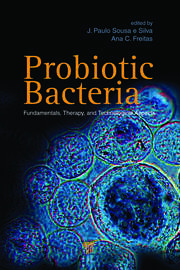ABSTRACT
Probiotics have been associated with many health-promoting effects, primarily focused on the gastrointestinal (GI) tract beneits through several modulating activities, but also demonstrating promising applications at other locations of the body, namely at respiratory and genital tract and subcutaneous tissue (Marco et al., 2006). It is recognized that due to the numerous beneicial activities that can be assigned to probiotics, more than one mechanism of action is required to explain the effects of their activity that are generally explained by direct or indirect modiication of the endogenous
microbiota or the immune response. These beneicial properties are strain dependent, and although several properties may be attributed to a speciic strain, the multiple activities are in general achieved by microorganism interaction either among them or with the host (Marteau and Shanahan, 2003). Figure 3.1 summarizes the main mechanisms of action displayed by probiotic bacteria when in contact with gut mucosa. Concerning the improvement of endogenous microbiota, the colonization by probiotic bacteria involves, in irst place, the adhesion of these bacteria to in situ cell receptors allowing for the competition for the sites of adhesion and for nutrients, reducing number of available receptors as well as accessible nutrients to be used by pathogenic bacteria. This adhesion is generally considered a pre-requisite for colonization that should not be permanent, but only transient colonization (Ouwehand et al., 1999). During their colonization and through their growth and metabolism, they can release antimicrobial substances, including bacteriocines-natural antimicrobial substances (generally of proteinaceous nature that can have a lipid or carbohydrate moiety) or organic acids (namely lactic and acetic acids, hydrogen peroxide, among others) that consequently decrease the local pH. These natural antimicrobials contribute toward in situ inhibition of pathogens. In addition, via immunological activation, they can also promote pathogen inhibition through induction of cytokine production or the increase in situ IgA secretion. Apart from that, these beneicial microorganisms can also protect from toxins released in situ, generated from food digestion or by microorganisms, through the entrapment of toxins and consequent elimination from the gut. During their permanence in the gut, they can improve epithelial and tissue integrity and functionality, mainly through the production of low amounts of nitric oxide (NO) synthesis, enhancement of mucus production, improvement of gut epithelia cell proliferation, inhibition of carcinogenic substances production or elimination through detoxiication, and generation of nutrients, namely production of short fatty acids and vitamins (Steidler, 2001). The mucus provides a barrier that protects the intestinal immune cells from the high level of antigens present in gut lumen and short-chain fatty acids (SCFAs) are the major source of energy for colonocytes and its deiciency has been suggested to promote colitis.


